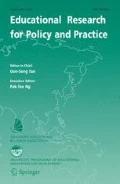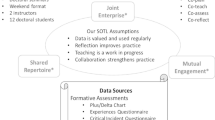Abstract
The No Child Left Behind Act requires that educators at all grade levels use Scientifically Based Research (SBR) instructional practices. Researchers constructed a literature-based model to examine the predictive relationship between a state’s comprehensiveness of planned implementation and its capacity to implement the plan. An approach comprised survey research, and content analysis was employed to test the model and determine factors predicting SBR implementation. Findings indicated that cross functional linkages, consequential loss of funding, and inter-organizational partnerships were predictors of the comprehensiveness of implementation.

Similar content being viewed by others
References
Choi, B. C. K., & Pak, A. W. P. (2007). Multidisciplinary, interdisciplinary, and transdisciplinarity in health research, services, education and policy: Promoters, barriers, and strategies of enhancement. Clinical and Investigative Medicine, 30, E224–E232.
Connolly, P., & Lukas, C. (2002). Strengthening nonprofit performance: A funder’s guide to capacity building. St. Paul, MN: Amherst H. Wilder Foundation.
Cooper, B. S., Fusarelli, L. D., & Randall, E. V. (2004). Better policies, better Schools: Theories and applications. Boston: Pearson/Allyn and Bacon.
Corcoran, T. (2003). The use of research evidence in instructional improvement. Consortium for Policy Research in Education Policy Briefs. Retrieved from http://www.cpre.org/Publications/rb40.pdf.
Feigenbaum, E. (2013). Types of organizational structures in the public sector. Retrieved from http://smallbusiness.chron.com/types-organizational-structure-public-sector-4892.html.
Gamse, B. C., Jacob, R. T., Horst, M., Boulay, B., & Unlu, F. (2008). Reading First impact study final report (NCEE 2009–4038). Washington, DC: National Center for Education Evaluation and Regional Assistance, Institute of Education Sciences, U.S. Department of Education.
Goals 2000: Educate America Act H.R. 1804 (103rd). (1994).
Government Accountability Office. (2007). Reading First: States report improvements in reading instruction but additional procedures would clarify education’s role in ensuring proper implementation by states (GAO-07-161). Retrieved from http://www.gao.gov/cgi-bin/getrpt?GAO-07-161.
Haager, D., Dhar, R., Moulton, M., & McMillan, S. (2009). The California Reading First year 7 evaluation report. EDS Publications. Retrieved from http://www.eddata.com/resources/publications/RF_Evaluation_2008-2009.pdf.
Manzo, K. (2007). Reading First contractor neglected bias rules. Education Week. Retrieved from http://www.edweek.org.
Manzo, K. (2008). Federal path for reading questioned: Reading First poor results offer limited guidance. Education Week. Retrieved from http://www.edweek.org.
No Child Left Behind Act of 2001, P.L. 107–110, 20 U.S.C. §6319 (2002).
Race to the Top Act of 2001 H.R. 1532 (112th). (2011).
Rotherham, A. J. (2003). Hopes and hazards: No Child Left Behind & low performing public schools. The State Education Standard. National Association of State Boards of Education, 30–35.
U.S. Department of Education, Office of Elementary and Secondary Education. (2002). No child left behind: A desktop reference. Retrieved from http://www.ed.gov/Speeches/04-2002/20020417b.html.
U.S. Department of Education, Institute of Education Sciences, National Center for Education Evaluation and Regional Assistance. (2003). Identifying and implementing educational practices supported by rigorous evidence: A user friendly guide. Retrieved from http://www.ed.gov/rschstat/research/pubs/rigorousevid/guide_pg9.html?exp=0.
Zehr, M. (2009). Though unproved, Early Reading First likely to continue. Education Week. Retrieved from http://www.edweek.org.
Zhang, L. (2011). Organizational changes in state education agencies: Responses to standards-based accountability. Dissertation. College Park, MD: University of Maryland. Retrieved from http://drum.lib.umd.edu/handle/1903/11852.
Author information
Authors and Affiliations
Corresponding author
Appendices
Appendix A
1.1 Checklist of the SBR components
Directions: Each component will be scored as follows:
- 3 :
-
if the state plan exceeds beyond that comprehensively stated in the act
- 2 :
-
if the state plan explicitly matches the act
- 1 :
-
if the state plan partially matches the act
- 0 :
-
if the state plan does not contain the component.
-
(1)
The process by which the State educational agency, using expert review, will select local educational agencies to receive sub grants.
-
(2)
The selection criteria by which the State educational agency, using expert review, will select local educational agencies to receive subgrants.
-
(3)
How the State educational agency will ensure that funds are limited to comprehensive school reform programs that
-
(a)
employ proven strategies and proven methods for student learning that are
-
\(\approx \) based on scientifically based research and
-
\(\approx \) effective practices and
-
\(\approx \) have been replicated successfully in schools
AND
-
-
(b)
employ proven strategies and proven methods for teaching that are
-
\(\approx \) based on scientifically based research and
-
\(\approx \) effective practices and
-
\(\approx \) have been replicated successfully in schools
AND
-
-
(c)
employ proven strategies and proven methods for school management that are
-
\(\approx \) based on scientifically based research and
-
\(\approx \) effective practices and
-
\(\approx \) have been replicated successfully in schools
-
-
(d)
(i) have been found, through scientifically based research, to significantly improve the academic achievement of students participating in such program as compared to students in schools who have not participated in such program;
or
-
(d)
(ii) have been found to have strong evidence that such program will significantly improve the academic achievement of participating children.
-
(a)
-
(4)
That indicates how the State educational agency will disseminate materials and information on comprehensive school reforms that are
-
\(\approx \) based on scientifically based research and
-
\(\approx \) effective practices.
-
-
(5)
That indicates how the State educational agency will provide technical assistance:
-
\(\approx \) the local educational agency or consortia of local educational agencies, and
-
\(\approx \) participating schools, in
-
\(\approx \) evaluating,
-
\(\approx \) developing, and
-
\(\approx \) implementing comprehensive school reform.
-
Appendix B
1.1 Examples of items on the survey
The intent of this survey is to investigate various factors’ relationships with the implementation of Scientific Based Research (SBR) as delineated in the NCLB Act. We appreciate your time and effort in this endeavor to add to the understanding of this process.




Rights and permissions
About this article
Cite this article
Mohammed, S., Walker, D.A., Conderman, G. et al. Implementing scientific-based research: learning from the history of the reading first program. Educ Res Policy Prac 15, 27–40 (2016). https://doi.org/10.1007/s10671-015-9173-4
Received:
Accepted:
Published:
Issue Date:
DOI: https://doi.org/10.1007/s10671-015-9173-4




